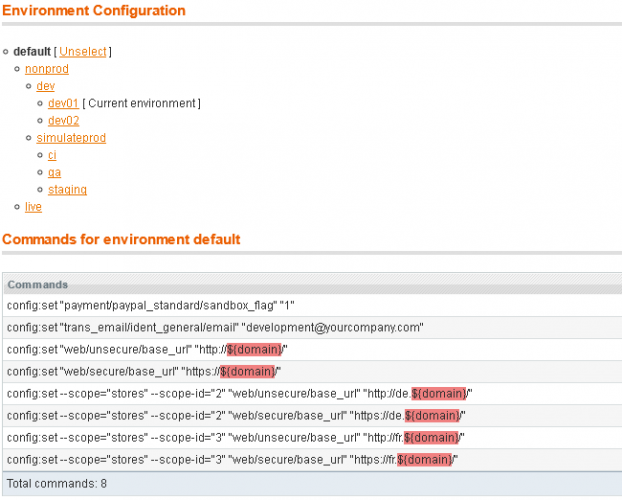What can EnvironmentConfiguration do?
EnvironmentConfiguration uses the power of n98-magerun to execute arbitrary commands on a Magento installation. Do whatever is necessary to adjust your configuration to the given environment with one command-line call:
n98-magerun.phar ls:env:configure [environment]We use our extension for:
- configuring several environment stages (development, test, staging, production)
- configuring several development environments
- anonymising data
- activating / deactivating cronjobs
- activating / deactivating modules
- changing configuration settings and URLs
- changing license keys and login data
- switching between sandbox and production mode for PSP gateways
- activating / deactivating caches
- and more.
I'll give you a glimpse on what you can do in this article.
Installation and Setup
At first you have to get the code. You can download it from GitHub and copy it to your Magento installation or install it via modman. Of course you can also opt to use Composer. The extension has been added to the Firegento Composer Repository and is available at 'limesoda/limesoda_environment-configuration'.
Once the extension is put in place you have to define the name for your environment. We do this in local.xml because this file is used for environment-specific configuration data like database credentials and you probably want to choose a unique name for every instance. You can define the name anywhere you like as long as the information eventually gets merged into the Magento configuration XML.
Let us call our environment "dev01":
<config>
<global>
<limesoda>
<environment>
<name>dev01</name>
</environment>
</limesoda>
</global>
</config>Everything we configure goes into the global > limesoda node. (We namespace our settings to avoid conflicts with other extensions.)
That's the basic setup. Now we can create environment configurations.
A sample project
In our example we will create the foundation for what could become a complex project. If you don't want to work with outdated databases or spend hours and hours of re-adjusting databases (and getting problems because you forget to set something manually) you'll have to figure out a way to manage your environments with less effort.
This are the requirements for our sample project:
- Developers work in separated working copies.
- There is a CI environment for automated testing and code analysis, a QA for manual testing and client approval, a staging environment to make sure everything works in a production-like environment and finally the production system.
- In addition to the default store, we have a German and a French store view.
- The PayPal sandbox has to be used for non-production systems (obviously).
- The general e-mail address has to be adjustable per environment so that mails always the right person/team. (In a real project, you'll have to set many more fields, this is an example.)
- In non-production systems we want to replace the customer e-mail addresses with our own address so no customer can get e-mails. (Again, in a real project you would strip customer data, use a mail catcher, anonymise all customer data or replace the e-mails in all database tables. Just to point out that you shouldn't use this code as-is in any real project!)
- Some cronjobs should be disabled everywhere because wo don't need them, some should be disabled in non-production systems because they'll flood our mail boxes or they must not be run in these instances for whatever reason.
- The developers want to have their caches disabled by default but other environments should enable the cache for better performance and to catch issues before they go into production.
We know now what we have to do. Time to get your hands dirty.
Show me some code!
At first, let me show you the fully-fledged environment configuration of our example. Take a breath, glance over the XML and don't run away. We'll depict the functionalities in a moment.
<?xml version="1.0"?>
<config>
<modules>
<Mzeis_Project>
<version>1.0.0</version>
</Mzeis_Project>
</modules>
<global>
<limesoda>
<environments>
<default>
<system_configuration>
<default>
<payment><paypal_standard><sandbox_flag>${paypal_sandbox_flag}</sandbox_flag></paypal_standard></payment>
<trans_email><ident_general><email>${email_localpart}@${email_domainpart}</email></ident_general></trans_email>
<web><unsecure><base_url><![CDATA[http://${domain}]]></base_url></unsecure></web>
<web><secure><base_url><![CDATA[https://${domain}]]></base_url></secure></web>
</default>
<stores>
<german_store>
<web><unsecure><base_url><![CDATA[http://de.${domain}]]></base_url></unsecure></web>
<web><secure><base_url><![CDATA[https://de.${domain}]]></base_url></secure></web>
</german_store>
<french_store>
<web><unsecure><base_url><![CDATA[http://fr.${domain}]]></base_url></unsecure></web>
<web><secure><base_url><![CDATA[https://fr.${domain}]]></base_url></secure></web>
</french_store>
</stores>
</system_configuration>
<variables>
<email_domainpart>yourcompany.com</email_domainpart>
<email_localpart>development</email_localpart>
<paypal_sandbox_flag>1</paypal_sandbox_flag>
</variables>
</default>
<nonprod parent="default">
<system_configuration>
<default>
<system><cron><disabled_crons>currency_rates_update,catalog_product_alert,newsletter_send_all</disabled_crons></cron></system>
</default>
</system_configuration>
<commands>
<db_sfq>db:execute 'UPDATE sales_flat_quote SET customer_email = "${email_localpart}@${email_domainpart}"'</db_sfq>
</commands>
</nonprod>
<dev parent="nonprod">
<post_configure>
<cc>cache:disable</cc>
<cf>cache:flush</cf>
</post_configure>
</dev>
<dev01 parent="dev">
<variables>
<domain>abc.development.tld</domain>
<email_localpart>j.smith</email_localpart>
</variables>
</dev01>
<dev02 parent="dev">
<variables>
<domain>xyz.development.tld</domain>
<email_localpart>j.doe</email_localpart>
</variables>
</dev02>
<simulateprod parent="nonprod">
<post_configure>
<cc>cache:enable</cc>
<cf>cache:flush</cf>
</post_configure>
</simulateprod>
<ci parent="simulateprod">
<variables>
<domain>ci.development.tld</domain>
</variables>
</ci>
<qa parent="simulateprod">
<variables>
<domain>qa.development.tld</domain>
</variables>
</qa>
<staging parent="simulateprod">
<variables>
<domain>staging.stagingserver.tld</domain>
</variables>
</staging>
<live parent="default">
<variables>
<domain>liveshop.com</domain>
<email_domainpart>merchant.com</email_domainpart>
<email_localpart>support</email_localpart>
<paypal_sandbox_flag>0</paypal_sandbox_flag>
</variables>
<system_configuration>
<default>
<system><cron><disabled_crons>currency_rates_update,catalog_product_alert</disabled_crons></cron></system>
</default>
</system_configuration>
<post_configure>
<cc>cache:enable</cc>
<cf>cache:flush</cf>
</post_configure>
</live>
</environments>
</limesoda>
</global>
</config>Define environments
The first thing you'll notice is that the file looks like a config.xml. That's because it is nothing else. You can put the configuration in any configuration XML file in your installation or even split it up in several files if you choose to do so.
We defined several environments and used the inheritance feature to build a hierarchy. This is done by declaring a "parent" attribute with the parent environment name as the value:
<default />
<nonprod parent="default">
<dev parent="nonprod">and so on. As a project matures you may have to restructure the hierarchy when the requirements and environments change.
In the XML above we created the following tree:
- default
- nonprod
- dev
- dev01
- dev02
- simulateprod
- ci
- qa
- staging
- dev
- live
- nonprod
Define variables
You are able to define variables that can be used in commands and system configuration settings. Variables are declared in the<variables>
<email_domainpart>yourcompany.com</email_domainpart>
<email_localpart>development</email_localpart>
<paypal_sandbox_flag>1</paypal_sandbox_flag>
</variables><variables>
<email>${email_domainpart}@${email_localpart}</email>
</variables>Adjust the system configuration
A big part of configuring an environment is setting the correct values in System > Configuration. Therefore we created a special<system_configuration>
<default>
<web><unsecure><base_url><![CDATA[http://${domain}]]></base_url></unsecure></web>
</default>
<stores>
<german_store>
<web><unsecure><base_url><![CDATA[http://de.${domain}]]></base_url></unsecure></web>
</german_store>
<french_store>
<web><unsecure><base_url><![CDATA[http://fr.${domain}]]></base_url></unsecure></web>
</french_store>
</stores>
</system_configuration>Executing arbitrary n98-magerun commands
The system_configuration section we just got to know actually only is a convenience wrapper for using the command "n98-magerun.phar set:config" because this way of declaring values is more clear when setting many values. In fact, you can execute any n98-magerun command in thedb:execute 'UPDATE sales_flat_quote SET customer_email = "${email_localpart}@${email_domainpart}"'<cc>cache:enable</cc>
<cf>cache:flush</cf>Command stages
One apparent disavantage of the XML configuration is that you cannot be totally sure in which order the commands are executed because of the way the commands are declared and merged. As a light-weight solution, we added three "command stages" a.k.a. "groups of commands where you can put commands in just to be sure that some commands get executed before others". The stages are called:- pre_configure
- commands
- post_configure
How do I get a better overview of my environments and settings?
Let's be honest: XML is verbose and with a large configuration is't not always easy to see what will be set or if you missed something. To help with this you can find an overview in the backend menu "System > Environment Configuration":

